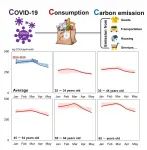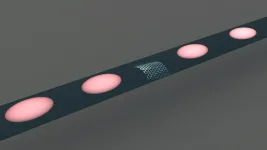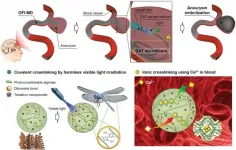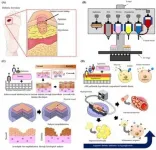(Press-News.org) AMES, Iowa - New variants of the SARS-CoV-2 virus most likely will necessitate the development of more vaccine options in the years ahead, and a biomedical scientist at Iowa State University believes the "key" to that development lies in the way the virus binds to human cells.
Michael Cho, a professor of biomedical sciences at Iowa State, is studying how to develop COVID-19 vaccines that target SARS-CoV-2's receptor-binding domain, or the part of the virus that docks with the host cellular receptor, angiotensin converting enzyme 2 (ACE2). This docking process allows the virus access to the host's cells, which leads to infection.
Cho was the lead author of a study recently published in the peer-reviewed scientific journal Frontiers in Immunology detailing the ability of a vaccine to induce antibodies in mice that target the virus's receptor binding domain. The patent-pending vaccine approach is available for licensing from the Iowa State University Research Foundation. Cho will deliver a virtual presentation on the potential of the approach to BioConnect Iowa's vaccine and immunotherapeutics meeting on Wednesday.
The antibodies produced by the experimental vaccine attack the receptor binding domain, or RBD, of the virus. The RBD is the portion of the viral spike protein that binds to host cells to initiate infection. Cho likens the spike protein to a key, and the RBD is the part of the key that actually enters the lock.
"The spike glycoprotein is the key that opens the lock, and the region of the key with all the peaks and valleys and grooves is the RBD," Cho said. "If antibodies attack the RBD, then the key won't work and the door will stay locked, preventing infection. We don't really need to make antibodies against the entire spike protein, which is more difficult to make. We can just focus on the RBD portion."
This approach differs from the three vaccines currently available in the United States to ward off COVID-19. The mRNA vaccines produced by Pfizer and Moderna work by delivering a set of instructions that teach the immune system how to make the entire spike protein that triggers an immune response. The Johnson & Johnson vaccine is known as a viral vector vaccine that uses a modified version of a different virus.
Cho and his colleagues conducted trials of the RBD subunit protein vaccine on mice and were able to induce a potent antibody response in the rodents over the course of three injections. The study showed that one or two injections are sufficient, depending on the adjuvant used. Cho said he would like to test the approach in human trials.
Easy to produce, scale up
The RBD-targeting vaccine has some advantages over the vaccines currently licensed for use in the United States. Cho said the experimental vaccine is relatively easy to produce and scale up because it requires only a small portion of the virus's spike protein to manufacture. The RBD vaccine also can be delivered multiple times, which could be necessary to develop immunity against multiple virus variants that will inevitably emerge.
Cho said the process of reaching herd immunity to COVID-19 through vaccines will take time, allowing for new variants of the virus to spread. This is particularly true for populations in developing countries that have had only limited access to the currently available vaccines so far. And as more variants emerge, the likelihood grows that additional vaccines will become necessary, he said.
"Just because we have vaccines now, that doesn't mean we won't need more in three or five years, maybe even longer," he said. "I don't think our vaccine is too late to play a role."
The 2021 Immunotherapeutics Virtual Conference is presented by Iowa State, the University of Iowa and BioConnect Iowa. The conference aims to connect cutting-edge university research with industry leaders. Cho will address the virtual conference Wednesday morning. Registration information is available at https://www.isupark.org/news/registration-open-for-2021-iowa-vaccines-and-immunotherapeutics-conference/.
INFORMATION:
Unlike the oscillations of sound waves, the oscillations of light are so fast that extremely complex equipment is needed to observe them directly. However, it is possible to measure the frequencies of these oscillations indirectly with frequency combs. These combs are made up of a set of regularly spaced "teeth" where each tooth corresponds to a frequency. Used as a graduated ruler, they offer the possibility of measuring an optical frequency with great precision. This makes it possible, among other things, to measure variations in the distance between the Earth and the Moon with an accuracy ...
MADISON - By engineering a short chunk of protein, or peptide, that can prevent the attachment of human parainfluenza viruses to cells, researchers have improved a method in rodent models intended to help keep children healthy.
Human parainfluenza viruses, or HPIVs, are the leading cause of childhood respiratory infections, responsible for 30% to 40% of illnesses like croup and pneumonia. The viruses also affect the elderly and people with compromised immune systems.
To sicken people, HPIVs must latch onto cells and inject their genetic material to start making new viruses. HPIV3 is the most prevalent among these viruses. ...
Autistic people have far greater risks of long term physical health conditions than others, but the reasons for this remain unclear. New research from the University of Cambridge suggests that unhealthy lifestyle habits may be an important contributing factor. The results are published today in the journal Molecular Autism.
Earlier research suggests that autistic people die 16-35 years younger than expected, and that greater health problems may contribute to this risk. The present study is the first to consider the diet, exercise, and sleep patterns of autistic adults and how these patterns may relate to health outcomes.
The team at the Autism Research Centre in Cambridge developed an anonymous, online survey about lifestyle choices and daily habits, personal medical history, ...
The Covid-19 pandemic, like many other health crises, has had unequal effects on the U.S. population, with communities of color often hit the hardest. A new study co-authored by an MIT professor identifies a related challenge: Different social groups have different reactions to the fact that Covid-19 has generated those health inequities.
More specifically, the study, based on a multilayered survey of U.S. residents, finds a divergence among racial groups when people are informed about the varying effects of the pandemic. Upon learning more about the social distribution of Covid-19, Black Americans tend to gain a better understanding of their risk. But among white Americans given the same information, ...
Australian photovoltaics researchers have made a 'cool' discovery: Singlet fission and tandem solar cells - two innovative ways to generate solar power more efficiently - also help to lower operating temperatures and keep devices running for longer.
Tandem cells can be made from a combination of silicon - the most commonly used photovoltaics material - and new compounds like perovskite nanocrystals, which can have a larger bandgap than silicon and help the device to capture more of the solar spectrum for energy generation.
Singlet fission, meanwhile, is a technique that produces twice the electronic charge carriers than normal for each photon of light that's absorbed. ...
A chemical that the NSW government has recently partially banned in firefighting has been found in the pups of endangered Australian sea lions and in Australian fur seals.
The finding represents another possible blow to Australian sea lions' survival. Hookworm and tuberculosis already threaten their small and diminishing population, which has fallen by more than 60 percent over four decades.
The new research - part of a long-term health study of seals and sea lions in Australia - identified the chemicals in animals at multiple colonies in Victoria and South Australia from 2017 to 2020.
As well as in pups, the chemicals (Per- and polyfluoroalkyl substances - 'PFAS') were detected in juvenile ...
Despite the rapid and significant changes in consumption patterns witnessed during the initial months of the COVID-19 pandemic, Japanese households maintained their normal levels of greenhouse gases emissions. The "anthropause" -- reduction of human activity due to the pandemic -- made headlines last summer, but factory shutdowns and broken global supply chains did not translate into the adoption of eco-friendly lifestyles for the average household.
"During the early COVID-19 period, we could witness lifestyle changes happening around us fast, so we decided to explore the environmental impacts of these lifestyle changes. Some other research at that period was showing that the production-side greenhouse gases emissions ...
The promise of a quantum internet depends on the complexities of harnessing light to transmit quantum information over fiber optic networks. A potential step forward was reported today by researchers in Sweden who developed integrated chips that can generate light particles on demand and without the need for extreme refrigeration.
Quantum computing today relies on states of matter, that is, electrons which carry qubits of information to perform multiple calculations simultaneously, in a fraction of the time it takes with classical computing.
The co-author of the research, Val Zwiller, Professor ...
Cerebral aneurysms are malformations caused by abnormalities on the walls of blood vessels in the brain. When these blood vessels rupture, about 30% of the sufferers die on the spot, giving these the rightful label of 'ticking bombs in the head'. Recently, a research team at POSTECH has come up with a new treatment that can disassemble these time bombs by filling the aneurysm in blood with a new method.
In order to overcome the shortcomings of coil embolization, POSTECH's joint research team (Professor Joonwon Kim and Dr. Jongkyeong Lim of the Department of Mechanical Engineering with Professor ...
The skin, which covers the surface of the human body, is its largest organ. It is the first organ to show changes stemming from organ or physiological activity. It is especially common for diabetic patients to suffer from skin diseases or infections. Recently, a POSTECH research team has succeeded in creating a 3D artificial skin that enables observation of skin diseases of diabetic patients.
A research team led by Professor Dong-Woo Cho and Minjun Ahn of POSTECH's Department of Mechanical Engineering and Professor Byoung Soo Kim of School of Biomedical Convergence Engineering at Pusan National University has ...






